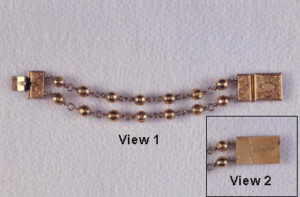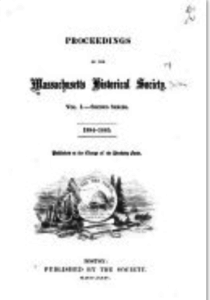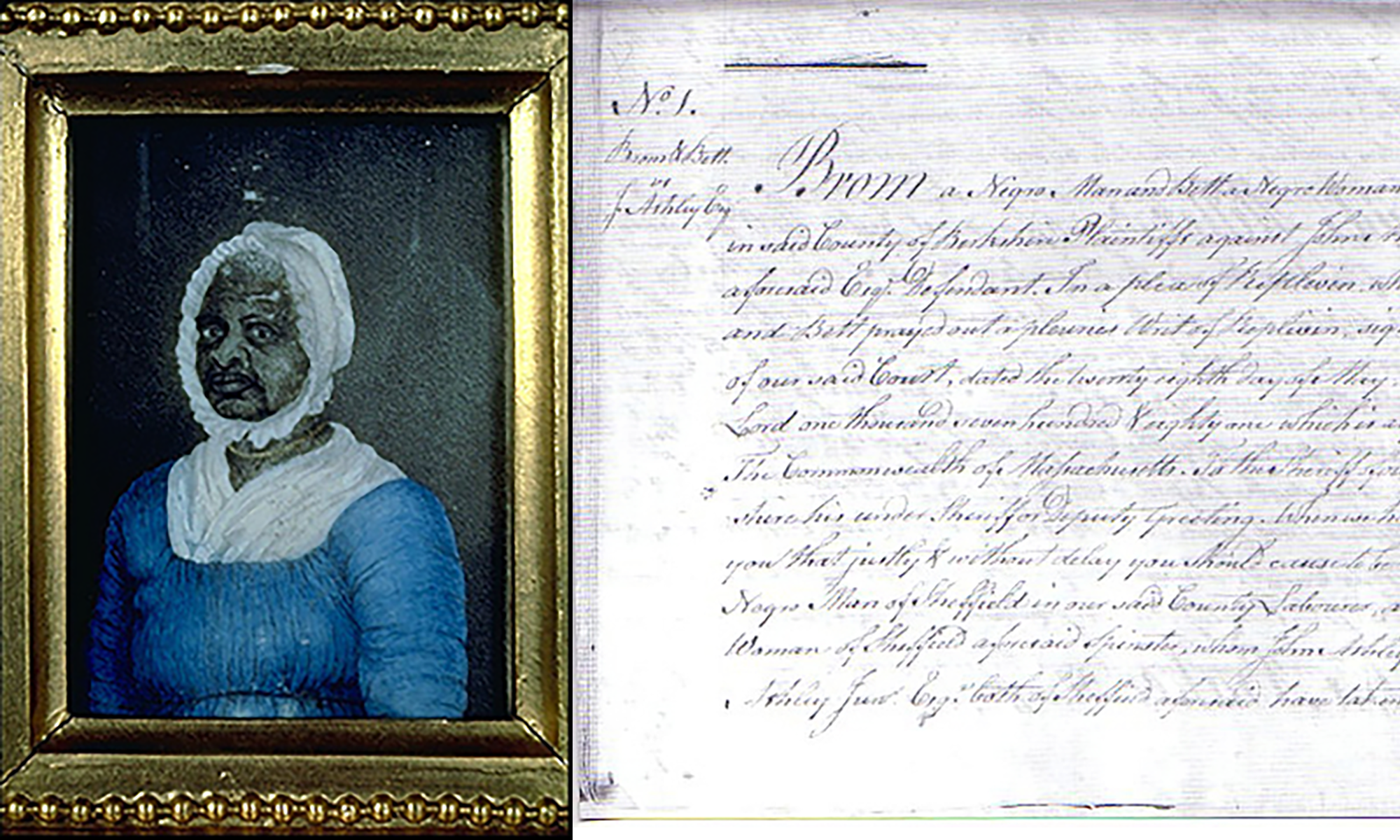
Bracelet – Late eighteenth century
Double strand of gold beads made into a bracelet with etched clasp
L. 5 3/4 in. (14.6 cm), w. in. (1.3 cm) Engraved, inside clasp:
Mumbet
Gift of William Minot, 1884
This bracelet is at the
Massachusetts Historical Society
1154 Boylston Street
Boston, Massachusetts
The gold beads worn by Elizabeth “Mumbet” Freeman as a necklace as shown in Susan Ridley Sedgwick’s 1811 miniature portrait of Mumbet and the bracelet is in the possession of the MHS in Boston. Prior to her death in 1829, Mumbet gave the beads to Catharine Maria Sedgwick, daughter of Judge Theodore Sedgwick. Some of the beads were apparently lost over the years, and Catharine had the remainder remade into a double strand bracelet with gold separators between beads to replace those lost. The clasp with its rococo-revival engraving probably dates from this time, approximately 1840. The bracelet can be seen at the MHS.

Found the following excerpts from Proceedings of the Massachusetts Historical Society, December 31, 1884
Another gift to our Society has reached me within a few days past, which has many interesting and touching associa tions. It comes from William Minot, Esq., the son of our late Resident Member of the same name, and the grandson of one of our most eminent founders, George Richards Minot. I can describe the gift in no language so appropriate as that of the letter which accompanied it.
39 Coubt Street, Jan. 2, 1884.
Dear Mr. Winthrop, — Soon after the passage of our State Bill of Rights iu 1783, an African female slave, by tlie name of Mumbet, was emancipated in Sheffield by process of law, brought to a fiual judgment in her favor by Mr. Theodore Sedgwick. Mumbet subsequently entered Mr. Sedgwick’s service as his children’s nurse, and died in his home in Stockbridge, greatly respected and beloved by his family. She was in the habit of wearing a necklace of gold beads, and just before her death she gave this necklace to Miss Catherine M. Sedgwick, the youngest daughter of Judge Sedgwick. Miss Sedgwick valued it highly, and had the beads formed into a bracelet as more convenient for her own wear. At her death she gave the bracelet to her niece, my wife, who in turn left it to my daughter. .lately deceased. There can be no doubt of its genuineness, and it is a curious and interesting relic as having belonged lo the first slave ever emancipated by process of law in Massachusetts, if not in the United Suites. By an accident, some of the beads were lost. To preserve those remaining, I have had them reunited, whence the smallness of the bracelet as it now is. As a relic, valuable for its associations, it marks so striking an epoch in our social and political progress, that I thought it might be worthy of a place in the Cabinet of the Massachu setts Historical Society. If you agree with me. will you be so kind as to request the Society to become the custodian of it? Very sincerely yours, Wit. Minot. Hon. Robert C. Winthrop.
This little relic thus conies to our Cabinet, associated not only with the memories of Theodore Sedgwick, the old Speaker and Senator in Congress and a Judge of the Supreme Court of Massachusetts, and of his daughter, Miss Catherine Sedgwick, the accomplished authoress, and of other members of their family more recently and sadly deceased, but with the humble African servant, greatly respected and beloved by that family, who is believed to have been the very first subject of emancipation under the Massachusetts Bill of Rights in 1783. I am sure you will all desire to offer a grateful acknowledg ment to Mr. Minot, and I venture to offer the following Resolution: —
Resolved, That the thanks of this Society be returned to William Minot, Esq., for the very interesting relic which he has presented for our Cabinet, and that we shall gladly give it a place among our most precious memorials.
Pages 2-4
[Following found on page 41]
“Mr. Uriel H. Crocker, of Boston, was elected a Resident Member of the Society, and General George W. Cullum, U.S.A., was chosen a Corresponding Member. The President mentioned that lie had received a letter from the Rev. George W. Blagden, D.D., who, having removed to New York, had ceased to be a Resident Member, but had been nominated by the Council for the Corresponding Roll. Mr. Young then said : —
After the necklace which belonged to “Mumbet” was presented to our Society at its last meeting,1 I made in quiries to ascertain whether she was identical with Elizabeth Freeman, who was a negro woman of extraordinary intelli gence, and whose manumission in 17s:’>, it has been believed, was the first fruit of the declaration in the Massachusetts Bill of Rights, ‘-that all men are born free and equal,” and led to the abolition of slavery in this Stale.- I was informed by Mr. William Minot that she was the same person, and that her name originated in this way: Elizabeth, Betsey, Bet; then Madam Bet, the prefix having been given by her fellow servants, out of respect to her capability and character; then Marm Bet, which was contracted by the children in the family to Mumbet.
Mr. Minot has also sent to our Library a pamphlet entitled “Restoration of Natural Rights,” written with much ability and vigor by Henry Dwight Sedgwick, second son of Judge Sedgwick, and published in New York in 1831, which is interesting as one of the early articles on the practicability of abol ishing African slavery in this country. In this pamphlet are detailed many particulars relating to the life and liberation of the domestic slave above mentioned, who was considered a remarkable person in Berkshire, and who died at a very advanced age, greatly beloved and lamented. A picture of Mum Bet, which was taken in 1811, accompanies this pamphlet, and is presented to our Cabinet by Miss Maria B. Sedgwick. It was painted by her mother, Mrs. Theodore Sedgwick, the wife of the oldest son of Judge Sedgwick, who was a lady of great accomplishments, and well known to her contemporaries as the author of some charming tales. It adds much to the interest attaching to the keep sake which we have already received, that we now have this miniature likeness of the wearer and this historical account of her. I beg leave to propose that the thanks of the Society be tendered to Miss Sedgwick and Mr. Minot for their accep table gifts.” Pages 41 and 42
